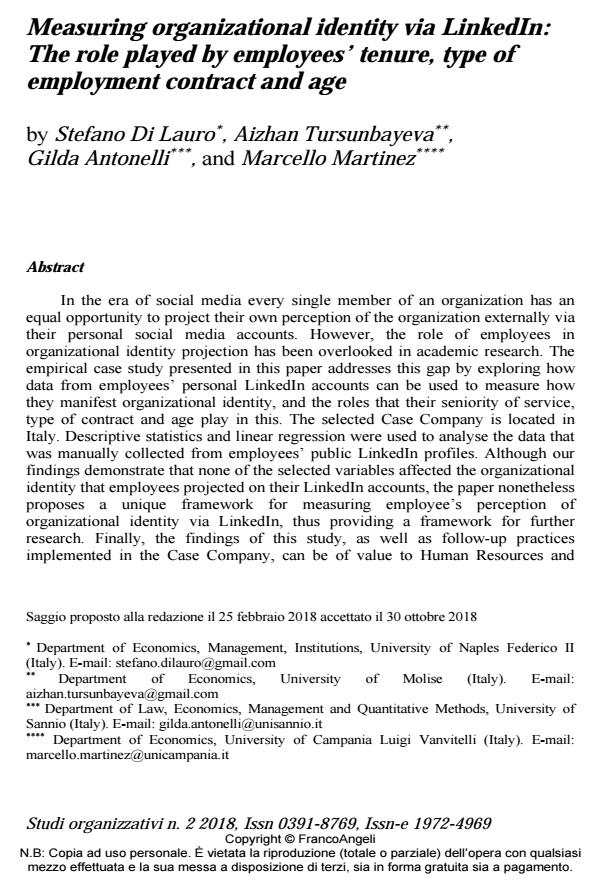Measuring organizational identity via LinkedIn: The role played by employees’ tenure, type of employment contract and age
Titolo Rivista STUDI ORGANIZZATIVI
Autori/Curatori Stefano Di Lauro, Aizhan Tursunbayeva, Gilda Antonelli, Marcello Martinez
Anno di pubblicazione 2019 Fascicolo 2018/2
Lingua Inglese Numero pagine 16 P. 114-129 Dimensione file 243 KB
DOI 10.3280/SO2018-002005
Il DOI è il codice a barre della proprietà intellettuale: per saperne di più
clicca qui
Qui sotto puoi vedere in anteprima la prima pagina di questo articolo.
Se questo articolo ti interessa, lo puoi acquistare (e scaricare in formato pdf) seguendo le facili indicazioni per acquistare il download credit. Acquista Download Credits per scaricare questo Articolo in formato PDF

FrancoAngeli è membro della Publishers International Linking Association, Inc (PILA)associazione indipendente e non profit per facilitare (attraverso i servizi tecnologici implementati da CrossRef.org) l’accesso degli studiosi ai contenuti digitali nelle pubblicazioni professionali e scientifiche
In the era of social media every single member of an organization has an equal opportunity to project their own perception of the organization externally via their personal social media accounts. However, the role of employees in organizational identity projection has been overlooked in academic research. The empirical case study presented in this paper addresses this gap by exploring how data from employees’ personal LinkedIn accounts can be used to measure how they manifest organizational identity, and the roles that their seniority of service, type of contract and age play in this. The selected Case Company is located in Italy. Descriptive statistics and linear regression were used to analyse the data that was manually collected from employees’ public LinkedIn profiles. Although our findings demonstrate that none of the selected variables affected the organizational identity that employees projected on their LinkedIn accounts, the paper nonetheless proposes a unique framework for measuring employee’s perception of organizational identity via LinkedIn, thus providing a framework for further research. Finally, the findings of this study, as well as follow-up practices implemented in the Case Company, can be of value to Human Resources and Social Media practitioners who are considering whether to introduce or already implementing social media use practices in organizations. .
Nell'era dei social media ogni singolo membro ha le stesse opportunità di proiettare esternamente la propria percezione dell'organizzazione a cui appartiene attraverso i propri account personali. Ciò consente alle organizzazioni di comunicare la propria immagine verso l’esterno attraverso molti più canali. Tuttavia, la letteratura esistente non ha preso in considerazione il ruolo dei dipendenti nella proiezione dell'identità organizzativa, di fatto lasciando inesplorata un’area in grande evoluzione. Lo studio empirico presentato in questo articolo affronta questa lacuna utilizzando un metodo quantitativo (regressione lineare) e propone un framework originale per misurare la percezione dell'identità organizzativa da parte di dipendenti tramite LinkedIn. In particolare la ricerca mira a comprendere come le informazioni contenute negli account personali LinkedIn dei dipendenti possano essere utilizzate per misurare l'identità organizzativa, considerando l’influenza sull’uso del social network giocata dal ruolo ricoperto, dall’anzianità di servizio, dal tipo di contratto e dall’età del lavoratore. Le ipotesi sono testate in una impresa italiana leader nel suo settore ed i risultati dimostrano che nessuna delle variabili prese in considerazione sembra avere influenzato l'identità organizzativa che i dipendenti proiettano sui loro account LinkedIn. I risultati della ricerca e le pratiche di follow-up implementate nella organizzazione oggetto di indagine possono essere utili ai professionisti delle risorse umane e dei social media che vogliano introdurre o implementare le pratiche di utilizzo dei social media nelle organizzazioni.
Parole chiave:Identità organizzativa; cambiamento organizzativo; social media; Linkedin; misurazione
- Critical Issues on Changing Dynamics in Employee Relations and Workforce Diversity Francesca Di Virgilio, pp.121 (ISBN:9781799835158)
- Exploring Innovation in a Digital World Stefano Di Lauro, Aizhan Tursunbayeva, Raluca Bunduchi, Gilda Antonelli, Marcello Martinez, pp.291 (ISBN:978-3-030-87841-2)
Stefano Di Lauro, Aizhan Tursunbayeva, Gilda Antonelli, Marcello Martinez, Measuring organizational identity via LinkedIn: The role played by employees’ tenure, type of employment contract and age in "STUDI ORGANIZZATIVI " 2/2018, pp 114-129, DOI: 10.3280/SO2018-002005